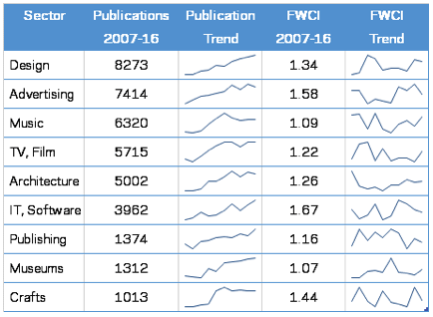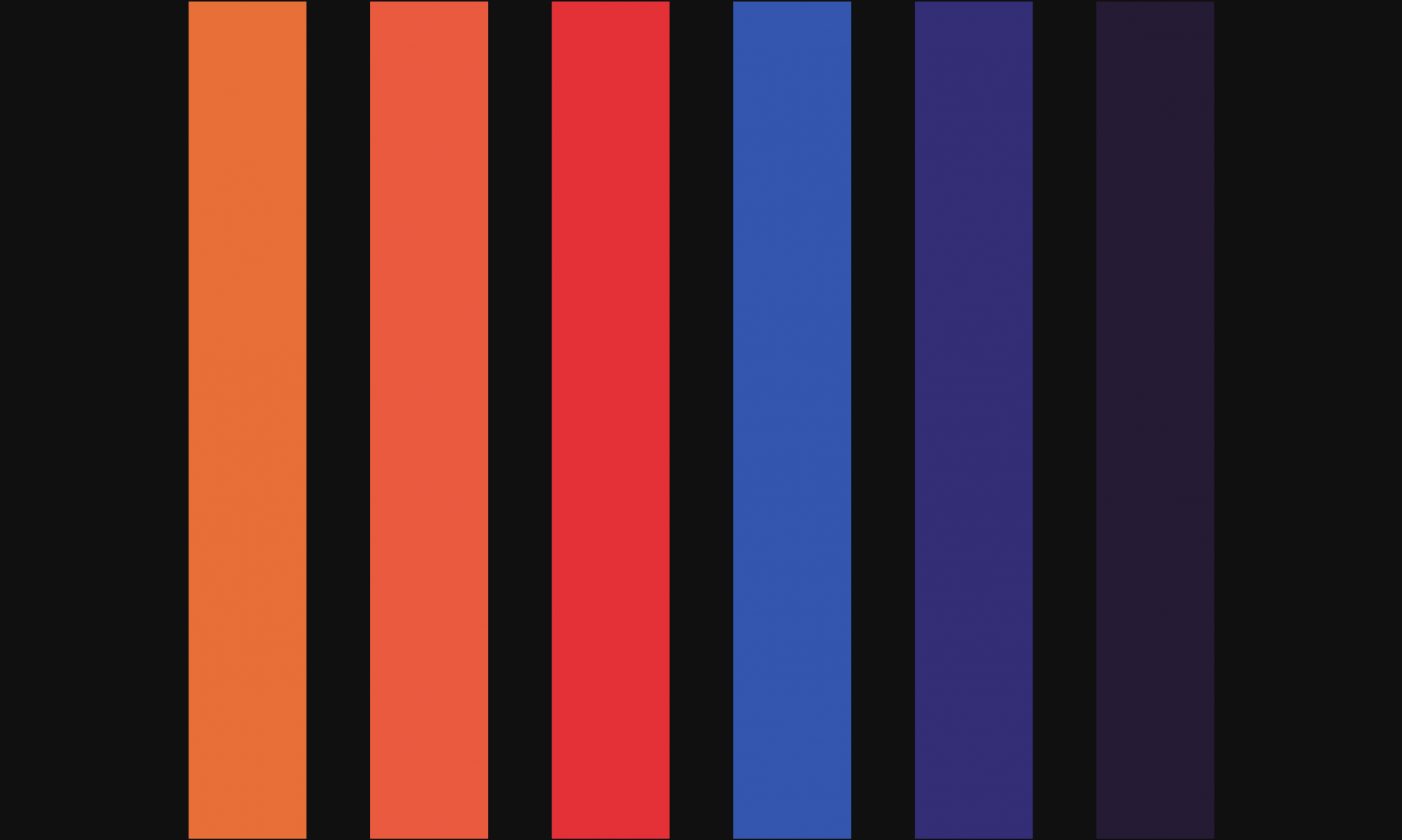
Summary of a research report undertaken by Elsevier for the Creative Economy Champion programme
James Doeser and Graham Hitchen
Introduction
This essay summarises the findings from a bibliometric assessment of the research strengths of the Creative Industries. In order to support the evidence base for the Creative Industries Clusters Programme, the publisher Elsevier was commissioned to undertake this study by the Creative Economy Champion in 2018 – to provide insights on academic research on Creative Industries and to map university-industry links in the sector as revealed by publications data.
The research found that the sector has a vibrant and much-utilised scholarly research community. Creative Industries research is found in publications from all manner of disciplinary traditions (most obviously in Arts and Humanities, but also Engineering, Computer Science, and Business). Although a small proportion of research papers had a direct collaboration with industry, those papers tended to have a bigger impact on subsequent scholarship.
Finding the right key words
A bibliometric study uses data from publications (in this case peer-reviewed journal articles, academic books and conference proceedings) to understand the shape and strengths of a particular field (or fields) of scholarship. The Creative Industries are notoriously hard to define and cross over a wide range of disciplines and industrial subsectors.
An initial set of keywords and phrases for each of the DCMS nine sectors was arrived at through text-mining sector documents. These were then filtered and expanded for relevancy by the project team and experts from BOP Consulting. The final keyword list for each sector was used to query a Scopus database of publications limited to the 2007-2016 period. This identified a corpus of publications per sector. A set of different indicators was then calculated for each corpus. These indicators revealed something about the strengths and characteristics of research publications in the Creative Industries.
A set of indicators for the corpus of publications
The first major indicator was ‘Field-Weighted Citation Impact’ (FWCI) – an indicator of citation impact, which compares the actual number of citations received by an article with the expected number of citations for articles of the same document type (article, review, or conference proceeding), publication year, and subject field. Using FWCI strongly reduces the biases against Arts and Humanities and Social Sciences that would have emerged in the use of non-normalised indicators. The indicator is therefore always defined with reference to a global baseline of 1.0.
A second important indicator – ‘Academic-Corporate Collaboration’ – was used to identify those publications that had at least one author affiliated to a corporate entity, as a way of tracking industry collaboration.
In this study Scopus affiliation profiles were generated automatically through algorithms and complemented by manual curation to achieve full accuracy.
Findings

The overall corpus of Creative Industries included 36,438 publications for the 2007-16 period, with an average FWCI of 1.33 – ie. above the mean. The sector that had the largest output was Design, whereas IT & Software had the largest impact. Publications in the Design sector had the steepest growth and have not yet stalled. Despite dips through the analysis period, most of the other fields also tended to have grown in output volume. Music, Crafts and TV, Film sector publications had slowed down over the final five years.

The majority of publications relevant to the Creative Industries sector were in the fields of Social Sciences, Arts & Humanities, Computer Science, Engineering, and Business, Management & Accounting. While these results can be partially affected by the limitations introduced into the keyword search, they are also predictable. The actual share changes across sectors – while for most sectors Arts & Humanities and Social Sciences publications account for the majority of the publications, Engineering is the leading area for Architecture, Computer Science is the leading area for Design, and Business, and Management & Accounting is the leading area for Advertising.
Only a small proportion of papers had a corporate collaborator. This study found that, on average, 2.7% of all the publications identified in the Creative Industries had one corporate collaborator. Although very low, to a certain extent this is not surprising. The conditions which result in a corporate collaboration in the mix of authors is dependent on all manner of factors: there needs to be individual or institutional connections already established, the research in question needs to result in a publication caught in the Scopus database, and the corporate co-authors needed to make the choice to put themselves forward and retain their affiliation in the publication process.
Not all sectors had the same level of corporate collaboration. The highest number and share of joint publications were in the Design sector where academic-corporate publications accounted for 5.5% of all publications. Museums (2.82%), TV & Film (2.78%) and Advertising (2.75%) also had a higher-than-average share of joint publications when compared to the Creative Industries overall.
Another measure of the sector-relevant-impact of research is the presence of citations in patents. Patents are used to protect the intellectual property associated with inventions or novel technologies. Cultural and creative content tends to be protected through other mechanisms of intellectual property protection. Nonetheless it’s easy to imagine how research in the Creative Industries feeds the process of innovation that will lead to a patent. For the Creative Industries corpus overall, there were 76 publications that were cited by patents and 117 patents that cited those publications. The majority of the publications and patents are from TV & Film (28 publications, 44 patents) and Design (21 publications, 30 patents), followed by Advertising (11 publications, 20 patents).
Reflections
Definitions continue to be a headache for rigorous research into the shape and size of research in the Creative Industries. None of the major bibliometric data providers (Scopus, Web of Science, Dimensions) have a subject classification for ‘Creative Industries’. One approach that could be taken would be to limit the research to subject areas around Arts & Humanities – but this would result in the exclusion of considerable research coming from other subject areas like Computer Science, which are highly relevant to the Creative Industries. Indeed, Computer Science and Engineering are two areas where bibliometric indicators have matured, become increasingly endorsed and validated – and, as is evident above, feature Creative Industries research.
In some ways, the kaleidoscopic nature of the Creative Industries sector is one of its unique strengths. It means that curious niches are created which occasionally link together with other fields to result in new and interesting discoveries and advances. The bibliographic data in this study has revealed the breadth of connections. It is vitally important that funders and policymakers appreciate that these connections are not just within and between cultural or arts disciplines but stretch into science, engineering and medicine.
A 2017 King’s College London report cited by Elsevier affirms the interdisciplinary nature of research in the creative and cultural sector: “The creative and cultural sector was linked to research from a wide range of academic disciplines. While there are strong disciplinary links between research in the arts and humanities, considerable interdisciplinary activity also takes place between the sector and all fields of academic research.”
This interdisciplinarity can make bibliometric analyses a challenge for mapping the scholarship underway in the Creative Industries. However, they are still of merit and are likely to become more important and useful as the sector matures and its many mutating definitions settle into place.
April 2021

